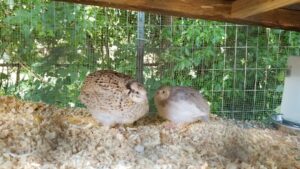Keeping quail is an ideal method for urban meat raising but it’s not without its learning curve.
Here’s how my experience went:
I sourced fertilized eggs from a small supplier via a Cotournix quail Facebook group. They were shipped quickly and safely and I’ll order from them again when I’m ready to do the next hatch.
Expect to pay around $30 for 3 dozen eggs. Prices will vary though, especially for breeders who specialize in rare or unusual breeds.
Most importantly: have all of your infrastructure ready to go. Before I even bought eggs, I had an incubator, brooder box and cage with all accessories and food on hand.
As well, buy a decent incubator. I built a DIY system and even though I was home quite a bit to check on temps and rotate eggs, I found it very difficult to keep an even temperature (around 99 degrees) and to regulate humidity. As a result, I had a poor hatch rate, and I want to emphasize that it was due to poor temp control, not the fault of the egg supplier. Again, buy a well reviewed incubator. It’s worth it.
Watching quail hatch is remarkable. Resist the urge to help them if they seem like they’re struggling to get out of their shell. The hatching process, from my observation, is nature’s way of building a strong bird. Because I was a worrier, I helped a bird that was struggling out of its shell and it ended up having a splay leg. I spent a week splinting the world’s tiniest leg but it couldn’t be corrected and eventually I had to cull that bird. Birds that are weak, if they don’t die from illness or malnourishment first, will probably be harmed by other birds as part of the pecking order.
If you’re raising birds as a means of providing calories for your dinner table, you need to let nature determine these sorts of things. As humans, we project many of our emotions onto these creatures and while it’s important to be ethical and compassionate, extending suffering is not a goal.
The surviving birds ended up being robust and active. After spending 4 weeks growing out their adult feathers in a brooder box away from cats and other dangers, we moved them to a roomy cage. We ended up keeping them longer than planned due to other life circumstances and I could not find time to conduct another hatch, so in early fall we harvested them for meat.
This was my first time actually cleaning a bird and I’m relieved to report that quail may be the best way to start learning such skills.
Because quail are small, they are easy to handle although don’t underestimate the strength of their wings, especially the males. I’ll link to a youtube video here that best shows how to harvest and clean quail quickly and humanely. I followed this exact method and within 15 minutes, had some meat in the freezer.
https://youtu.be/onPZGxf29Q0
It’s important to take into account the emotional toll involved in processing animals. It’s worth acknowledging that it’s hard to take the life of a living creature, so do the necessary introspection on what that means before even starting with meat animals.
That said, I’m glad to have added that skill and as we get settled on our new homestead, I’ll be ramping up the hatching and growing out process to keep my family supplied with healthy, lean meat.
Quail, of course, can also be kept just for eggs, keeping in mind it takes 3 to 5 quail eggs to equal one chicken egg. We did find that quail eggs were great for dishes that take a lighter egg like quiche or making a souffle. I’m interested in making mayonnaise from quail eggs.
Depending on how many birds you want to raise, quail can be kept in cages with a ratio of 1 male to every two to three females. You can also have an all female colony just for egg production. Do not house several males together as they will probably fight for dominance.
You can also scale up to build a fully enclosed aviary. Quail need either less than two feet of clearance in cages, or in an aviary, at least six feet. The reason for this is because quail are easily spooked and when they are startled, they jump straight up. If they have enough room to gain too much speed in too little space, they can break their necks.

Quail enclosures, regardless of size, need to be made from hardware cloth that’s predator proof. They are very vulnerable to raccoons, dogs, cats, birds of prey and other predatory and opportunistic wildlife. Chicken wire can be bent or torn by most motivated predators. Keep your enclosure secured.
Quail eat a high protein diet. Most people opt for turkey crumbles from the feed store. Quail can be messy, wasteful eaters and there’s a variety of feeder designs that minimize waste. It’s also worth growing fodder/microgreens for your birds to enjoy, especially ones in cages that cannot access grass or other growth.
Always keep plenty of fresh water available in dishes that won’t tip. When quail are in the brooder stage, make sure the water dishes are shallow enough that they won’t fall in and drown.
I referred to this book frequently:
Quail Farming For Beginners: The Ultimate Comprehensive Guide
by Amazon.com
Learn more: https://www.amazon.com/dp/1727090365/ref=cm_sw_em_r_mt_dp_qBzNFbC07SSYJ
It’s comprehensive yet concise and covers everything a beginner quail enthusiast needs to know.
Currently I’m planning a second hatch during early winter. I’ll report back on that in a second article.
